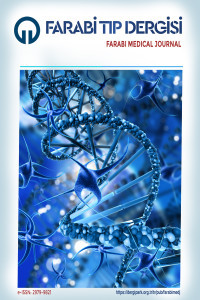Yoğun Bakım Ünitesinde Valproik Asit Kaynaklı Ciddi Toksisite Tedavisinde Hemodiyaliz, Levokarnitin ve Meropenem Uygulaması
Giriş: Valproik asit (VPA) günümüzde epilepsi, bipolar bozukluk, şizoafektif bozukluk, şizofreni ve migren profilaksisinde kullanılabilen bir ilaçtır. Valproik asit zehirlenmesi merkezi sinir sistemi depresyonu, şok, akut hiperammonemi, beyin ödemi, koma ve ölümle sonuçlanabilir. Bu olguda şiddetli VPA toksisitesi nedeniyle levokarnitin, hemodiyaliz ve meropenem tedavisi uyguladığımız bir hastayı sunmak istedik.
Olgu: 41 yaşında erkek hasta önce acil servise sonrasında Yoğun Bakım Ünitesi’ne bilinç bulanıklığıyla getirildi. Glasgow Koma Skoru 6 ve solunumu yetersiz olduğu için entübe edildi. Hastanın taşikardisi, hipotansiyonu, vasopressor ilaç ihtiyacı vardı. Karaciğer fonksiyon testleri normal bulunurken, hiperammoneminin ilaca bağlı olduğu düşünüldü. Hastanın kan valproat düzeyi 1055mg/L (terapötik normal aralık: 50-100mg/L) bulundu. Aspirasyon Pnömonisi gelişen hastaya valproik asit intoksikasyonunda yararlı olduğu saptanan meropenem verildi. Valproik asit zehirlenmesinin klinik belirtileri, merkezi sinir sistemi depresyonu, solunum depresyonu, hipotansiyon, metabolik asidoz, kemik iliği yetmezliği, beyin ödemi, hipoglisemi, hipernatremi ve hiperamonyemidir. Akut valproik asit zehirlenmesinin tedavisi genellikle destekleyici tedavi ve sıvı tedavisi, vazopresör desteği, elektrolit dengesizliği ve asit-baz bozukluklarının düzeltilmesini içerir. Olgumuzda başlangıç valproat düzeyi 1055 uq/ml olduğu için ilk tedavi olarak hemodiyalize başvurduk. Levokarnitin özellikle hiperammonemide yararlı olabileceğinden kullandık.
Sonuç: Sonuç olarak hemodiyaliz, levokarnitin ve meropenem kombine tedavisinin valproik asit düzeyini hızla düşürdüğü ve başarılı bir şekilde iyileşme sağladığını gözlemledik.
Anahtar Kelimeler:
Valproik asit, , intoksikasyon, Levokarnitin, Diyaliz, , Yoğun Bakım, Valproic acid, Intoxication, Levocarnitine
Hemodialysis, Levocarnitine and Meropenem Application in the treatment of severe Valproic Acid-Induced Toxicity in the Intensive Care Unit
Introduction: Valproic acid (VPA) is currently a drug that can be used in the prophylaxis of epilepsy, bipolar disorder, schizoaffective disorder, schizophrenia and migraine. Valproic acid poisoning can result in central nervous system depression, shock, acute hyperammonemia, cerebral edema, coma and death. In this case, we wanted to present a patient who was treated with levocarnitine, hemodialysis and meropenem due to severe VPA toxicity.
Case: A 41-year-old male patient was firstly brought to the emergency room and then Intensive Care Unit with confusion. The patients was intubated because of his Glasgow Coma Score of 6 and respiratory failure. The patient had tachycardia, hypotension, and needed vasopressor medication. While liver function tests were found to be normal, hyperammonemia was thought to be drug-related. The patient's blood valproate level was 1055mg/L (therapeutic normal range: 50-100mg/L). The patient who developed aspiration pneumonia was given meropenem, which was found to be beneficial in valproic acid intoxication. Clinical manifestations of valproic acid poisoning are central nervous system depression, respiratory depression, hypotension, metabolic acidosis, bone marrow failure, brain edema, hypoglycemia, hypernatremia, and hyperammonemia. Treatment of acute valproic acid poisoning usually includes supportive care and fluid therapy, vasopressor support, electrolyte imbalance, and correction of acid-base disorders. Since the initial valproate level was 1055 uq/ml in our case, we applied to hemodialysis as the first treatment. We used levocarnitine especially because it can be useful in hyperammonemia.
Conclusion: As a result, we observed that combined treatment of hemodialysis, levocarnitine and meropenem rapidly decreased the valproic acid level and resulted in a successful recovery.
Keywords:
Valproic acid, Intoxication, , , Levocarnitine, Dialysis, , Intensive Care,
___
- Lheureux PER, Hantson P. Carnitine in the treatment of valproic acid-induced toxicity in VPA toxicity. Clin. Toxicol. 2009; 47 (2): 101-111. DOI: 10.1080/15563650902752376.
- Sztajnkrycer MD. Valproic acid toxicity: Overview and management. J Toxicol Clin toxicol. 2002; 40: 789-801. DOI: 10.1081/clt-120014645.
- Lackmann GM. Valproic-acid-induced thrombocytopenia and hepatotoxicity: discontinuation of treatment? Pharmacology. 2004; 70: 57-58. DOI: 10.1159/000074668.
- Peces R, Fernández EJ, Sánchez RJ, Peces C, Montero A, Selgas R. Hemoperfusion in the treatment of acute valproic acid poisoning. Nefrologia. 2007; 27 (3): 370-373.
- Arslanköylü AE, Alakaya M, Akyilmaz E, Çelik Y, Delibaş A. Severe valproic acid poisoning responding to hemodialysis. Journal of Pediatric Emergency and Intensive Care. 2017; 4(2): 77-79. DOI: 10.4274/cayd.19483.
- Ishikura H, Matsuo N, Matsubara M, Ishihara T, Takeyama N, Tanaka T. Valproic acid overdose and L-carnitine therapy. J Anal Toxicol. 1996; 20(1): 55-58. DOI: 10.1093/jat/20.1.55.
- Jung J, Eo E, Ahn KO. A case of hemoperfusion and L-carnitine management in valproic acid overdose. Am J Emerg Med. 2008; 26(3): 388.e3-388.e388004. DOI: 10.1016/j.ajem.2007.07.032.
- Andersen GO, Ritland S. Life threatening intoxication with sodium valproate. J Toxicol Clin Toxicol. 1995; 33(3): 279-284. DOI: 10.3109/15563659509018000.
- Spiller HA, Krenzelok EP, Klein-Schwartz W, et al. Multicenter case series of valproic acid ingestion: serum concentrations and toxicity [published correction appears in J Toxicol Clin Toxicol 2001;39(1):115]. J Toxicol Clin Toxicol. 2000; 38(7): 755-760. DOI: 10.1081/clt-100102388.
- Perrott J, Murphy NG, Zed PJ. L-carnitine for acute valproic acid overdose: a systematic review of published cases. Ann Pharmacother. 2010; 44(7-8): 1287-1293. DOI: 10.1345/aph.1P135.
- Papaseit E, Farré M, López MJ, Clemente C, Campodarve I. A case of acute valproic acid poisoning treated successfully with L-carnitine. Eur J Emerg Med. 2012; 19(1): 57-58. DOI: 10.1097/MEJ.0b013e328345d67e.
- Garnier R, Boudignat O, Fournier PE. Valproate poisoning. Lancet. 1982; 2(8289): 97. DOI: 10.1016/s0140-6736(82)91713-5.
- Khobrani MA, Dudley SW, Huckleberry YC, et al. Intentional use of carbapenem antibiotics for valproic acid toxicity: A case report. J Clin Pharm Ther. 2018; 43(5): 723-725. DOI: 10.1111/jcpt.12705.
- Başlangıç: 2022
- Yayıncı: Karadeniz Teknik Üniversitesi
Sayıdaki Diğer Makaleler
Selim DEMİR, Ahmet MENTESE, Ayten LİVAOGLU, Elif AYAZOGLU DEMİR, Nihal TÜRKMEN ALEMDAR, Yüksel ALİYAZICIOĞLU
Ceren Nur DUYGUN ŞAHİN, Nagihan YILDIZ, Havva BAKAL, Ahmet EROĞLU
Yağ Dokusunda Katalaz Aktivitesi Ölçümü için Farklı İzolasyon Yöntemlerinin Karşılaştırılması
Sinem USTA, Ahmet ALVER, Elif ŞAHİN
Otizm Spektrum Bozukluğu Olan Çocuklarda Beslenme Tedavisi Yaklaşımları
Melis AKHALİL, Seda ÇİFTÇİ, Zehra BATU
İnternet Ortamında ve Sosyal Medyada Doğru ve Güvenilir Sağlık Bilgisi Edinebilme
